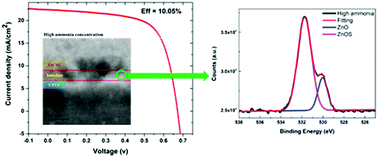Beyond 10% efficiency Cu2ZnSnS4 solar cells enabled by modifying the heterojunction interface chemistry†
Abstract
Wide band gap pure sulphide kesterite Cu2ZnSnS4 is a promising environmentally friendly and low-cost photovoltaic material, which has attracted intense research interest. However, the record efficiency of solar cells based on Cu2ZnSnS4 absorbers just overcame the benchmark 10%, being far from the efficiency requirement for industrial-scale deployment. Recombination at the heterojunction interface accounts for a large proportion of the performance loss. Here we report a substantial improvement of the Cu2ZnSnS4 solar cell efficiency to over 10% enabled by modifying the Cu2ZnSnS4/Zn1−xCdxS heterojunction interface. We found that the introduction of the ammonium hydroxide during the Zn1−xCdxS deposition process can lead to a significant reduction of Zn related hydroxide and oxide impurities. The modified chemistry environment at the heterojunction interface facilitates the decrease of interface defects and promotes the interface microstructure quality. The improved heterojunction interface with suppressed interface recombination contributes to the enhanced open circuit voltage, fill factor and overall device performance.

- This article is part of the themed collection: Research presented at the ICMAT 2019 symposium


 Please wait while we load your content...
Please wait while we load your content...